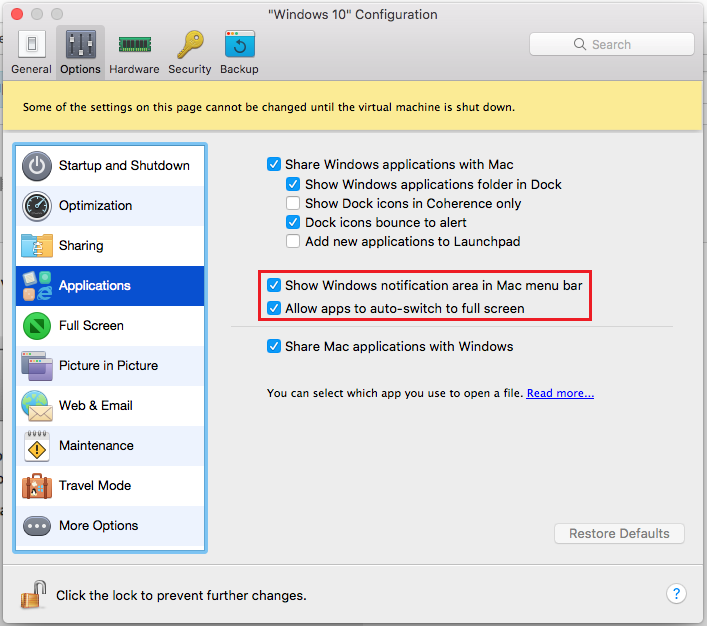Ever wish you could run macOS and Windows software, side by side, arranging windows from each operating system however you like? Thanks to a feature in Parallels called Coherence Mode, which you can use if you’ve set up Parallels to run Windows inside macOS, it’s only a click away.
In Parallels, this capability is called Coherence, and it is the default mode for Windows-based VMs. Parallels' Coherence mode allows you to run Mac and Windows programs side-by-side on the Mac desktop. For example, you might have Microsoft Word 2007 running alongside Safari for Mac. You could drag a link or an image from a Web page on Safari and drop. To exit Coherence mode, click on the Parallels tray icon in the Mac status bar and select View then click Exit Coherence. Or right-click on the Windows icon in the Dock and select View then click Exit Coherence.
In Coherence Mode, your virtual Windows desktop will merge with your Mac one, allowing you to arrange windows from the two operating systems side-by-side. You can think of it as a very polished version of VirtualBox’s seamless mode, but it’s more than that: the Parallels’ team laser focus on macOS means there are all sorts of integrations that similar tools wouldn’t even think to offer, like menus for Windows program in the menu bar and compatible keyboard shortcuts. It’s not quite as good as running a native Mac app, but it’s the next best thing.
Parallel's for mac. Postage to: United States, Canada, United Kingdom, Denmark, Romania, Slovakia, Bulgaria, Czech Republic, Finland, Hungary, Latvia, Lithuania, Malta, Estonia, Australia, Greece, Portugal, Cyprus, Slovenia, Japan, China, Sweden, Korea, South, Indonesia, Taiwan, Belgium, France, Hong Kong, Ireland, Netherlands, Poland, Spain, Italy, Germany, Austria, Bahamas, Israel, New Zealand, Philippines, Singapore, Switzerland, Norway, Saudi Arabia, Ukraine, United Arab Emirates, Qatar, Kuwait, Bahrain, Croatia, Republic of, Malaysia.
How to Launch Coherence Mode in Parallels
To get started, you need a Windows virtual machine with Parallels tools installed. Here’s how to set that up if you haven’t already. Open your virtual machine and you’ll see a blue button at the top left of the window, to the right of the usual Mac window buttons.
Click this and your Windows desktop will merge with your macOS one. Programs you have open in Windows run alongside your Mac ones, which is a little weird at first.
Parallels desktop 13 for mac high sierra. If you intend to upgrade your Mac to macOS High Sierra and keep using Parallels Desktop for Mac, we strongly recommend you upgrade to Parallels Desktop 14 for Mac. Here is the list of known issues we are working on with the available workaround that we have tested in our lab.
There are a few other integrations that make it easy to use everything together. You’ll find a sort of Start menu folder in the dock, making it easy to launch Windows software.
If you prefer the actual Windows start menu, complete with search, simply click the virtual machine’s icon in the dock; the full start menu will launch above your dock.
From here you can search Windows, or access any other functionality of the Windows operating system, all without leaving the macOS desktop.

And the integration goes further: look at the macOS menu bar and you’ll find the Windows tray icons.
Parallels For Mac Exit Coherence Not Working
Speaking of the menu bar: Windows programs are somewhat integrated with the macOS menu bar, allowing you to do things like Copy and Paste.
It’s a subtle thing, sure, but it makes the Windows applications feel just a little more at home in macOS.
How to Configure Coherence Mode (and Turn Certain Features Off)
If some of these integrations bother you, don’t worry: you can enable and disable most of them. Shut down your virtual machine, then click the gear button next to its name in the Control Center.
Head to the “Applications” section.
Here you’ll find the option to disable the applications folder in the dock and the notification area in the menu bar. This is a matter of taste: some people will like the integrations, and some would prefer to head to the full Windows environment to access things like the tray icons. Happily it’s all up to you.
No problems or bugs were found in our tests. The software supports all the popular platforms including Windows 10 and the MacOS Sierra. So the compatibility will be no longer questioned. https://golliberty.netlify.app/parallels-for-mac-review-2015.html. Optimized for Windows 10 and ready for MacOS Sierra The Parallels Desktop is no more older.
How to Exit Coherence Mode
Even with these integrations turned off, you might realize that Coherence isn’t for you, at least not constantly. No worries: it’s easy to turn off. Click the Parallels icon in the menu bar, then head to View > Exit Coherence.
Alternatively, you can right-click the virtual machine’s dock icon; you’ll find the same options.
Parallels For Mac Exit Coherence Shortcut
More Than Just Windows
Parallels is mostly designed to make running Windows programs on Mac simpler, but Windows isn’t the only trick it can pull: Linux virtual machines also work well. Such machines even support Coherence, once Parallels Tools is installed. Here’s how that looks with Ubuntu.

Parallels Turn Off Coherence Mode
The integrations aren’t quite as strong: a good chunk of the Ubuntu UI comes over wholesale, rather than finding a niche in the macOS dock and menu bar. But software runs, making it just a little easier to run Linux software alongside macOS apps.
READ NEXTParallels
- › How to Stream UFC 242 Khabib vs. Poirier Live Online
- › Free Download: Microsoft’s PowerToys for Windows 10
- › How to Overclock Your Computer’s RAM
- › What’s New in Chrome 77, Arriving September 10
- › How to Use Pipes on Linux